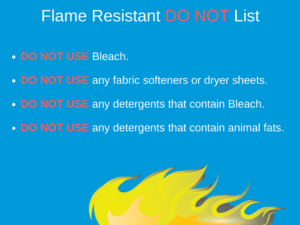Flame resistant clothing is vital for those who wear it. It's clothing that's specifically made to self-extinguish when it comes in contact with an open flame source.
If you wear it, or buy flame resistant clothing for your team, you appreciate its ability to provide superior protection from your environment. Because of how expensive it can be, you want it to last as long as possible.
But how long is too long? If there an end date on flame resistant clothing?
We recommend replacing your flame resistant clothing as soon as you notice minor wear, but we also know that budgets only stretch so far.
That's why we're writing this article. We wanted to put together some tips on how you can care for your flame resistant clothing. These tips will come in handy if you are responsible for cleaning your own flame resistant clothing. If your company is renting them for you, they take care of washing your clothing. This is critical for extending the longevity of the garments so they continue to keep you safe.
If this is your first experience with FR (flame resistant), we'll restate the reasons for these protective garments. These are garments that are worn in areas where a worker is exposed to flame or heat. They are intended to resist ignition, prevent the spread of flames, and self-extinguish almost immediately after removal from the original ignition source. Flame resistant clothing has specific requirements they must meet, including the National Fire Protection Association (NFPA) Standard 2112.
Let's start by reviewing the 4 types of flame resistant fabrics.
The 4 different types of flame resistant fabric
According to Bulwark, all FR fabric requires special safety and care considerations. There are currently four different variations:
- Inherently FR Fibers – these are defined as having flame resistance as an essential characteristic of the fiber. These fibers don't require additional flame resistant chemicals, due to the fibers being naturally flame resistant.
- Treated Fabrics – these are fibers that are treated with a chemical that makes them flame resistant. An example is cotton, which is not normally protective, but the treatment makes them FR.
- Treated Fibers – the fabric created from treated synthetic fibers. These fibers are extruded with a flame retardant chemical in the fiber-forming process. They become flame resistant for the life of the garment because wear of laundering cannot remove the chemical.
- Blends – some flame resistant fabric is a hybrid blend of treated and inherently FR fibers.
Why do I need to wash my FR clothing differently?
If this is a question you are asking yourself, then it's definitely important to note these points when washing any flame resistant clothing. Below are all the points from Bulwark, when washing your flame resistant clothing at home.
How to wash your FR clothing at home
- Wash separately in a Normal or Cotton cycle at any water temperature up to a maximum of 140ºF (60ºC). Use any typical home laundry detergent. Do not use soap (tallow soap containing animal fats).
- Turn garments inside out before washing to reduce streaking from abrasion.
- Fill the washer no more than 2/3 full and use high water level.
- Do not use chlorine bleach or liquid non-chlorine bleach.
- Do not use starch or fabric softeners. They may coat fibers and mask FR performance and/or serve as fuel in the event of garment ignition.
- Using conditioned or soft water can help improve the removal of contaminants from garments. Hard water precipitates soaps and can result in the build-up of calcium and magnesium salts. These can serve as fuel in the event they are exposed to a source of ignition.
- It is important that all soils and other contaminants are completely removed from garments during the wash process. This may require the use of stain removal products, such as Shout®, Spray 'n Wash®, or Zout®; or presoaking garments prior to washing. The use of hot water can often make detergents more effective in the removal of soils. If all contaminants cannot be removed in home care, garments should be dry cleaned.
- Do not over-dry garments. If chosen, you may press with an iron on the Permanent Press/Low setting.
- Always consult the garment manufacturer for detailed instructions and precautions.

Removing stains from flame resistant clothing
This point was mentioned in the previous steps, but we wanted to call it out specifically. Stains, depending on nature, can prohibit the flame resistant properties of your clothing. Stains should also be expected for the kind of environment flame resistant clothing is worn in.
If your garments should become contaminated with any flammable substances, they should be removed immediately and replaced with clean flame resistant apparel. Either home or industrial laundering may successfully remove most types of both flammable and non-flammable soils. However, home laundry detergents may not successfully remove some types of soil found on a job site. Heavy greases and any oily soils would fit this category and be a challenge during at-home laundering.
If flammable soils are not completely removed, the flame resistance of the garment may be compromised.
Flammable materials are, for the most part, volatile substances that dissipate into the atmosphere, like gasoline. Stains remaining after laundering, on the other hand, are either un-removed contaminants or, more likely, simply discoloration of the fabric.
With this said, it may be difficult to determine that flammable soils have been completely removed. But, indicators would include the presence of stains and/or odors after laundering.
However, staining alone is not an indication that the soil has not been adequately removed. If the garments may still be contaminated after home wash, laundering at a local commercial or industrial laundry may be required. Dry cleaning may be used to remove oils and greases.
In conclusion, you can see it's very important to care for your flame resistant clothing and to make sure the clothing isn't compromised and continues to work for you. When you are out in any potential hazard, safety is never "good enough."
Topics: Oil & Gas Thank You, Flame Resistant
.png?width=621&height=373&name=Model-Apparel%20Logo%20File%20from%20Ian%20(1.2).png)
.png)

